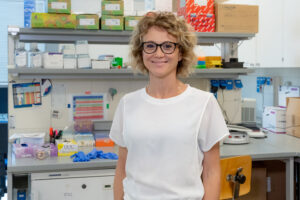ARI awards grants to fund innovative research that holds realistic promise in impacting the lives of autistic people. We continue to focus on education while supporting research on genetics, neurology, co-occurring medical conditions, nutrition, sensory processing, severe and challenging behaviors, and adult and senior issues. Connecting investigators, professionals, parents, and those on the spectrum worldwide is essential for effective advocacy.
NOTE: The pre-application period for 2024 ARI Scientific Research Grant proposals has concluded.
New in 2023: The Robert L. Hendren Research Grant Award

Dr. Robert Hendren
Inaugural Recipients – read about their investigations below
Emanuel DiCicco-Bloom, MD
Ed Levin, PhD
In honor of his many years of support for our work, serving as a member of ARI’s Scientific Advisory Board and Board of Directors, the top-scoring research grant proposals funded each year are now recognized as Robert L. Hendren Research Grant Award recipients.
More Research Studies
2023
A Broad-Range Anti-Inflammatory Treatment to Rescue Behavior Deficits and Microglia Dysfunction in the Shank3b Mouse Model of Syndromic Autism
Yuri Bozzi, Ph.D.
University of Trento
 Neuroinflammation causally represents a major environmental risk factor for autism spectrum disorder (ASD). Signs of inflammation have been reported in the cerebellum of autistic people and mouse models, along with cerebellar structural and functional defects. We showed that Shank3b-/- mice, compared to controls, display sensory hyporeactivity accompanied by a specific pattern of activation of the cerebellum. Since the cerebellum is involved in sensorimotor integration and social cognition, and expresses high levels of Shank3, we hypothesize that cerebellar inflammation contributes to the behavioral deficits of Shank3b-/- mice. During the course of our previous ARI-funded project, we showed that the antioxidant molecule N-acetylcysteine (NAC) rescued cerebellar inflammation, activation of microglia (the brain-resident macrophages responsible for neuroimmune defense), and social but not motor behavior in mutant mice, however inducing a certain degree of cerebellar inflammation in wild-type mice. Here we will test whether the anti-inflammatory drug astaxanthin (AST) can fully rescue social and motor deficits in Shank3b mutant mice with no adverse effect. The anti-inflammatory potential of AST will be tested by evaluating cytokine levels and microglia activation. These studies will allow us to determine whether a systemic anti-inflammatory treatment can rescue ASD-relevant deficits and neuroinflammation in Shank3b mice without toxic effects.
Neuroinflammation causally represents a major environmental risk factor for autism spectrum disorder (ASD). Signs of inflammation have been reported in the cerebellum of autistic people and mouse models, along with cerebellar structural and functional defects. We showed that Shank3b-/- mice, compared to controls, display sensory hyporeactivity accompanied by a specific pattern of activation of the cerebellum. Since the cerebellum is involved in sensorimotor integration and social cognition, and expresses high levels of Shank3, we hypothesize that cerebellar inflammation contributes to the behavioral deficits of Shank3b-/- mice. During the course of our previous ARI-funded project, we showed that the antioxidant molecule N-acetylcysteine (NAC) rescued cerebellar inflammation, activation of microglia (the brain-resident macrophages responsible for neuroimmune defense), and social but not motor behavior in mutant mice, however inducing a certain degree of cerebellar inflammation in wild-type mice. Here we will test whether the anti-inflammatory drug astaxanthin (AST) can fully rescue social and motor deficits in Shank3b mutant mice with no adverse effect. The anti-inflammatory potential of AST will be tested by evaluating cytokine levels and microglia activation. These studies will allow us to determine whether a systemic anti-inflammatory treatment can rescue ASD-relevant deficits and neuroinflammation in Shank3b mice without toxic effects.
Microbiome Dysbiosis in Autism Spectrum Disorders: Cellular and Molecular Mechanisms in a Gene x Environment Neurodevelopmental Disorders Model System
Emanuel DiCicco-Bloom, M.D.
Rutgers University, Robert Wood Johnson Medical School
 Approximately 17% of children are diagnosed with NDDs, including ASD, ADHD, and ID, which are highly heterogenous, frequently co-occur, and manifest in early life in sex-dependent fashion. We speculate that some of this heterogeneity is due to interactions between genetic risk factors and environmental exposures (G x E). During neurodevelopment, both the generation of new neurons, termed neurogenesis, and the gut microbiome are exquisitely sensitive to environmental factors, with recent evidence raising concern about childhood antibiotics. To examine this issue, we designed a new G x E model selecting 16p11.2 microdeletion mouse because this human variant increases ASD risk 38-fold, and exposure to the cephalosporin antibiotic, cefdinir. We assess effects on the gut microbiome, hippocampal neurogenesis and structure, gene expression, serum metabolome, and adult behaviors. Our preliminary results suggest that cefdinir exposure alters all these parameters, supporting a possible role of antibiotic-induced changes of the microbiome in ASD pathogenesis.
Approximately 17% of children are diagnosed with NDDs, including ASD, ADHD, and ID, which are highly heterogenous, frequently co-occur, and manifest in early life in sex-dependent fashion. We speculate that some of this heterogeneity is due to interactions between genetic risk factors and environmental exposures (G x E). During neurodevelopment, both the generation of new neurons, termed neurogenesis, and the gut microbiome are exquisitely sensitive to environmental factors, with recent evidence raising concern about childhood antibiotics. To examine this issue, we designed a new G x E model selecting 16p11.2 microdeletion mouse because this human variant increases ASD risk 38-fold, and exposure to the cephalosporin antibiotic, cefdinir. We assess effects on the gut microbiome, hippocampal neurogenesis and structure, gene expression, serum metabolome, and adult behaviors. Our preliminary results suggest that cefdinir exposure alters all these parameters, supporting a possible role of antibiotic-induced changes of the microbiome in ASD pathogenesis.
Proteomic Analysis of VNS-Sound Pairing Therapy Effects on Cortical Tissue in a Rat Model of ASD
Crystal Engineer, Ph.D.
University of Texas at Dallas
 Individuals with autism spectrum disorder (ASD) often exhibit auditory processing alterations. Despite undergoing extensive behavioral interventions, individuals frequently continue to experience deficits. Heterozygous Mecp2 rats are one of the rodent models used by my lab to model Rett syndrome, a rare genetic syndromic form of ASD. Extensive months-long training does not improve auditory processing in these rats. Our recent findings indicate that pairing vagus nerve stimulation (VNS) with auditory training restores auditory processing in this rat model. In this study, we will perform a global proteomics analysis of brain tissue to determine the protein changes involved in the enhanced neural responses observed before, during, and after VNS-sound pairing therapy. These experiments will provide insight into the proteomic changes associated with novel plasticity-based therapies in treating sensory processing deficits. This study represents a critical step in developing a deeper understanding of the neural mechanisms that subserve recovery, with a long-term goal to develop this novel plasticity-based therapy to treat sensory processing deficits in individuals with ASD.
Individuals with autism spectrum disorder (ASD) often exhibit auditory processing alterations. Despite undergoing extensive behavioral interventions, individuals frequently continue to experience deficits. Heterozygous Mecp2 rats are one of the rodent models used by my lab to model Rett syndrome, a rare genetic syndromic form of ASD. Extensive months-long training does not improve auditory processing in these rats. Our recent findings indicate that pairing vagus nerve stimulation (VNS) with auditory training restores auditory processing in this rat model. In this study, we will perform a global proteomics analysis of brain tissue to determine the protein changes involved in the enhanced neural responses observed before, during, and after VNS-sound pairing therapy. These experiments will provide insight into the proteomic changes associated with novel plasticity-based therapies in treating sensory processing deficits. This study represents a critical step in developing a deeper understanding of the neural mechanisms that subserve recovery, with a long-term goal to develop this novel plasticity-based therapy to treat sensory processing deficits in individuals with ASD.
Analysis of Urinary Organic Acids and their Relationship to ASD-related Symptoms
Rosa Krajmalnik-Brown, Ph.D.
James Adams, Ph.D.
Arizona State University


Urinary organic acid testing (OAT) is one of the most widely used tests by integrative physicians to evaluate children with autism and guide their treatment. It is powerful because it provides quantitative analysis of over 70 different organic acids, providing insight into many aspects of metabolism, including biomarkers for yeast, bacteria, glycolytic cycle, mitochondrial/Kreb cycle, neurotransmitters, vitamins, ketones, fatty acid oxidation detoxification, and amino acids. However, despite its widespread use for 20+ years by physicians, there is little formal published research on studies of it for autism.
Therefore, we propose to conduct urinary organic testing on 100 children with ASD and 70 typically developing (TD) children, all ages 2-11 years. This study will result in a determination of which organic acids have significantly different concentrations in children with ASD vs. TD. Multi-variate analysis will be used to integrate effects of multiple variables (age, gender) and to develop a combination panel of several metabolites for diagnosing ASD, and determine which combination of metabolites are most associated with specific symptoms.
We will also conduct pre/post analysis of 30 children with ASD who received microbiota transplant therapy to determine how microbiota transplant affects urinary organic acids, especially those related to bacteria and yeast.
Paternal Preconception Pesticide Exposure Effects on Neurodevelopmental Impairment in Their Offspring
Edward Levin, Ph.D.
Duke University
 Both maternal and paternal neurotoxic exposures can cause in their offspring behavioral impairments relevant to autism. Neurotoxic effects of maternal exposure have been well characterized, but paternal exposure effects are greatly understudied. We have shown in rat models that paternal preconception exposure to either delta-9 tetrahydrocannibinol (THC) or nicotine alters sperm DNA methylation and disrupts offspring neurobehavioral development, including emotional and cognitive impairments. This project extends the study of paternal-mediated neurotoxic effects to the adverse effects of an environmental toxicant, the insecticide diazinon, which is much used in commercial agriculture. Maternal diazinon exposure is known to impair neurobehavioral development in the offspring. Paternal diazinon effects will be investigated on offspring behavioral development and disruption of DNA methylation in paternal sperm and offspring brain. Male and female offspring from diazinon-exposed fathers will be assessed for locomotor hyperactivity, cognitive impairment, emotional dysregulation, and disruption of social behavior. Mechanistic studies will investigate the relationships between neurobehavioral and epigenetic effects of paternal preconception diazinon exposure.
Both maternal and paternal neurotoxic exposures can cause in their offspring behavioral impairments relevant to autism. Neurotoxic effects of maternal exposure have been well characterized, but paternal exposure effects are greatly understudied. We have shown in rat models that paternal preconception exposure to either delta-9 tetrahydrocannibinol (THC) or nicotine alters sperm DNA methylation and disrupts offspring neurobehavioral development, including emotional and cognitive impairments. This project extends the study of paternal-mediated neurotoxic effects to the adverse effects of an environmental toxicant, the insecticide diazinon, which is much used in commercial agriculture. Maternal diazinon exposure is known to impair neurobehavioral development in the offspring. Paternal diazinon effects will be investigated on offspring behavioral development and disruption of DNA methylation in paternal sperm and offspring brain. Male and female offspring from diazinon-exposed fathers will be assessed for locomotor hyperactivity, cognitive impairment, emotional dysregulation, and disruption of social behavior. Mechanistic studies will investigate the relationships between neurobehavioral and epigenetic effects of paternal preconception diazinon exposure.
Harnessing Psychedelics-Induced Neuroplasticity to Rescue Synaptic Pathology in a Human In Vitro Model of Autism Spectrum Disorder
Alessio Masi, Ph.D.
Università degli Studi di Firenze
 Loss of the SH3 and multiple ankyrin repeat domains 3 (Shank3) gene, resulting from rupture of chromosome 22, causes Phelan-McDermid syndrome, a rare genetic disorder with autism symptoms. In addition, Shank3 mutations are found in a considerable proportion of subjects with sporadic autism. Shank3 is a large protein playing a crucial structural role at synapses, the anatomical unit at the basis of communication between neurons. Shank3 mice exhibit self-injurious grooming, deficits in social interaction, and, at neuronal level, increased structural complexity associated with reduced spine density and functional defects in transmission, while isolated neurons from Shank3 mice exhibit a deficit in both excitatory and inhibitory synaptic activity, thus suggesting impaired network formation. Overall, studies conducted in animal and cellular models point to defects in excitability and synaptic transmission as key factors in autism with Shank3 mutations. My project aims at testing the efficacy of psychoactive drugs with the ability to promote neuroplasticity, known as “psychoplastogens”, on the molecular, structural, and functional features induced by Shank3 mutations. As experimental models, I will use primary cortical neurons from Shank3 mice, as well as cultured neurons carrying Shank3 mutations obtained by cell reprogramming of human skin cells.
Loss of the SH3 and multiple ankyrin repeat domains 3 (Shank3) gene, resulting from rupture of chromosome 22, causes Phelan-McDermid syndrome, a rare genetic disorder with autism symptoms. In addition, Shank3 mutations are found in a considerable proportion of subjects with sporadic autism. Shank3 is a large protein playing a crucial structural role at synapses, the anatomical unit at the basis of communication between neurons. Shank3 mice exhibit self-injurious grooming, deficits in social interaction, and, at neuronal level, increased structural complexity associated with reduced spine density and functional defects in transmission, while isolated neurons from Shank3 mice exhibit a deficit in both excitatory and inhibitory synaptic activity, thus suggesting impaired network formation. Overall, studies conducted in animal and cellular models point to defects in excitability and synaptic transmission as key factors in autism with Shank3 mutations. My project aims at testing the efficacy of psychoactive drugs with the ability to promote neuroplasticity, known as “psychoplastogens”, on the molecular, structural, and functional features induced by Shank3 mutations. As experimental models, I will use primary cortical neurons from Shank3 mice, as well as cultured neurons carrying Shank3 mutations obtained by cell reprogramming of human skin cells.
Identifying Neural Developmental Deficits at Cellular Resolution in a Human Neural Organoid Model of SCN2A
Karun Singh, Ph.D.
McMaster University

Microglia Ontogeny in the Pathogenesis of Autism Spectrum Disorders
Ana Teresa Tavares, Ph.D.
Universidade NOVA de Lisboa
 Autism spectrum disorders (ASD) are frequently combined with intellectual disability, immune dysfunction, and inflammatory diseases. Over the past decade, a growing body of evidence indicates that microglia, the resident immune cells of the brain, may contribute to the pathogenesis of ASD. In addition, recent studies suggest that differences in microglia formation between males and females may account for the higher prevalence of ASD in males. However, the molecular players that regulate sex differences in microglia ontogeny and their potential implication in ASD remain largely unknown. In this exploratory project, we will investigate the sexually dimorphic role of ASD-associated genes in microglia development. Specifically, we will study the function of genes expressed in the hematopoietic progenitors of microglia that are located on the X-chromosome and escape X-inactivation. To this aim, we will use female and male human induced pluripotent stem cells and compare the microglial differentiation potential and transcriptional profiles of wild-type and CRISPR-generated mutant clones. The results from this investigation are expected to provide new insights into sexual dimorphism in microglia ontogeny, as well as help clarify the etiological role of microglia dysfunction in ASD.
Autism spectrum disorders (ASD) are frequently combined with intellectual disability, immune dysfunction, and inflammatory diseases. Over the past decade, a growing body of evidence indicates that microglia, the resident immune cells of the brain, may contribute to the pathogenesis of ASD. In addition, recent studies suggest that differences in microglia formation between males and females may account for the higher prevalence of ASD in males. However, the molecular players that regulate sex differences in microglia ontogeny and their potential implication in ASD remain largely unknown. In this exploratory project, we will investigate the sexually dimorphic role of ASD-associated genes in microglia development. Specifically, we will study the function of genes expressed in the hematopoietic progenitors of microglia that are located on the X-chromosome and escape X-inactivation. To this aim, we will use female and male human induced pluripotent stem cells and compare the microglial differentiation potential and transcriptional profiles of wild-type and CRISPR-generated mutant clones. The results from this investigation are expected to provide new insights into sexual dimorphism in microglia ontogeny, as well as help clarify the etiological role of microglia dysfunction in ASD.
Genetic, Metabolomic, and Immunological Analysis for the Identification of Individual Differences in Autistic Subjects
Elisabetta Volpe, Ph.D.
Santa Lucia Foundation
 Heterogeneity is one of the key points of autism spectrum disorders (ASD). In fact, the large heterogeneity of symptoms renders both diagnosis and therapy difficult in ASD. Factors contributing to heterogeneity include genetic, immunological, and metabolic variabilities. We hypothesize that a large comprehensive analysis of biological factors combined with an extensive evaluation of behavioral assessments in ASD may lead to the identification of autism subtypes. We plan to integrate biological analysis (genetic, metabolic, and immunologic factors) and neuropsychiatric evaluation for each individual. Bioinformatic tools will allow us to identify biological factors discriminating ASD subtypes. This discovery could facilitate ASD diagnosis, improve knowledge of ASD etiology, and promote the design of future therapeutic strategies for ASD.
Heterogeneity is one of the key points of autism spectrum disorders (ASD). In fact, the large heterogeneity of symptoms renders both diagnosis and therapy difficult in ASD. Factors contributing to heterogeneity include genetic, immunological, and metabolic variabilities. We hypothesize that a large comprehensive analysis of biological factors combined with an extensive evaluation of behavioral assessments in ASD may lead to the identification of autism subtypes. We plan to integrate biological analysis (genetic, metabolic, and immunologic factors) and neuropsychiatric evaluation for each individual. Bioinformatic tools will allow us to identify biological factors discriminating ASD subtypes. This discovery could facilitate ASD diagnosis, improve knowledge of ASD etiology, and promote the design of future therapeutic strategies for ASD.

